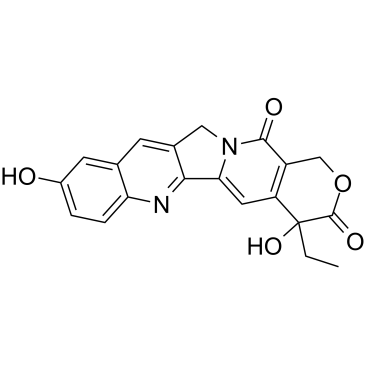64439-81-2
| Name | 10-Hydroxycamptothecin |
|---|---|
| Synonyms |
10-Hydroxycamptothecin
MFCD00274425 Camptothecin, 10-hydroxy EINECS 244-759-8 10-hydroxy-Camptothecin (4S)-4-Ethyl-4,9-dihydroxy-1H-pyrano[3',4':6,7]indolizino[1,2-b]quinoline-3,14(4H,12H)-dione |
| Description | (±)-10-Hydroxycamptothecin, an indole alkaloid isolated from Camptotheca acuminate, inhibits the activity of topoisomerase I and has a broad spectrum of anticancer activity. |
|---|---|
| Related Catalog | |
| Target |
Topoisomerase I |
| In Vitro | (±)-10-Hydroxycamptothecin (10-OH-camptothecin) is an inhibitor of topo I[1]. (±)-10-Hydroxycamptothecin (10-HCPT, 5-20 nM) markedly inhibits the proliferation of Colo 205 cells in a dose-dependent manner. (±)-10-Hydroxycamptothecin (5-20 nM) arrests Colo 205 cells in the G2 phase of the cell cycle and triggers apoptosis through a caspase-3-dependent pathway[2]. (±)-10-Hydroxycamptothecin (HPT, 0.01-10 μg/mL) causes cell shrinage, nuclear fragmentation and condensed chromosomes and induces apoptosis of human urinary bladder cancer cell line (T24)[3]. |
| In Vivo | (±)-10-Hydroxycamptothecin (10-HCPT, 2.5-7.5 mg/kg/2 days, p.o.) significantly suppresss tumor growth in mouse xenografts. (±)-10-Hydroxycamptothecin (1-7.5 mg/kg, p.o., once per 2 or 4 days) causes no obvious acute toxicity in nude mice[2]. |
| Cell Assay | Colo 205 cells (5 × 105) (ATCC: CCL-222) are seeded in 25T flasks overnight and then treated without (control) and with 5, 10, 15 or 20 nM of (±)-10-Hydroxycamptothecin, respectively. After treatment for 24-120 h, cells are harvested by trypsin-EDTA and then centrifuged at 1,500 rpm for 5 min at 4˚C. The cell pellet is resuspended in culture medium containing 0.04% trypan blue and the viable cells are enumerated by a hemocytometer[2]. |
| Animal Admin | BALB/c-nu mice are housed in a laminar flow room under sterilized conditions with a maintained temperature of 25 ± 2˚C and a controlled 12-h light and 12-h dark cycle. The Colo 205 cells are harvested and resuspended in serum-free RPMI-1640 medium. Cells are adjusted to 1 × 107 cells/mL, and transplanted 0.1 mL subcutaneously to the flank regions of the mice. Each experimental group included six to seven mice bearing tumors. (±)-10-Hydroxycamptothecin is dissolved in propylene glycol and treatment begins when the tumor size reach 3-5 mm. (±)-10-Hydroxycamptothecin is administered via p.o. once per two or four days at doses of 1, 2.5, 5, 7.5 mg/kg (volume of injection: 0.1 mL/20 g of body weight), respectively. The control group receives propylene glycol vehicle once per two days. Tumor size and body weight are monitored twice a week throughout the experiment. The tumor size is measured using a vernier caliper. Tumor volume (V) is calculated according to the formula: V (mm3) = 0.4AB2, where A and B are the longest diameter and the shortest diameter, respectively. At the end of the experiment, all mice are sacrificed by CO2 gas. Tumors, livers, kidneys and lungs are collected, fixed, embedded and stained with hematoxylin and eosin for pathological analysis[2]. |
| References |
| Density | 1.6±0.1 g/cm3 |
|---|---|
| Boiling Point | 820.7±65.0 °C at 760 mmHg |
| Melting Point | 230-237°C |
| Molecular Formula | C20H16N2O5 |
| Molecular Weight | 364.351 |
| Flash Point | 450.1±34.3 °C |
| Exact Mass | 364.105927 |
| PSA | 101.65000 |
| LogP | 1.32 |
| Vapour Pressure | 0.0±3.1 mmHg at 25°C |
| Index of Refraction | 1.777 |
| Storage condition | −20°C |
| HS Code | 2934999090 |
|---|---|
| Summary | 2934999090. other heterocyclic compounds. VAT:17.0%. Tax rebate rate:13.0%. . MFN tariff:6.5%. General tariff:20.0% |
